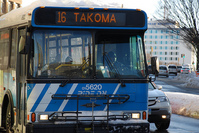Montgomery’s proposed budget takes transit funding and gives it to wealthy homeowners

Photo by Adam Fagen on Flickr.
Yesterday, Montgomery County Executive Ike Leggett unveiled his proposed budget, and it has no good news for transit riders. Ride On will get more state aid and hike fares, but it will not run any more buses. Instead, transit revenue will be used to cut real estate taxes.
The cost of running Ride On, as shown in the budget will go up $3.5 million, from $98 million to $101.6 million. Meanwhile, the county will receive $7 million in new revenues, double the cost increase. $5 million in new state aid will come from the gas tax increase passed last year. And fares will rise $2 million, likely a result of matching Metro’s fare increase.
Where will this money go? The county’s “mass transit tax,” a component of the real estate tax, will drop by $5 million. Bus riders, many of whom have low incomes or are renters, will pay more while a tax cut disproportionately benefits the county’s wealthiest homeowners.
When Maryland discussed a gas tax increase last year, many groups complained about “raids” on the state’s transportation trust fund, including county governments, legislators, conservatives, and the highway lobby. It will be interesting to see how these groups react to this diversion of trust fund money to non-transportation purposes.
Ride On could put the new money it is getting from the state and its riders to good use. The system lacks relief buses, or vehicles on standby, stationed around the county to fill in when other buses break down.
The county counts all late buses equally when it tracks Ride On’s performance, but for a rider, there’s a vast difference between a replacement bus that comes late and a bus that doesn’t come at all. If there’s no replacement, the next bus half an hour later might be so full that you can’t get on.
Other needed upgrades include restoring the connection to Frederick County buses in Urbana, straightening out the tangle of bus routes around downtown Bethesda, and better weekend service. Funding is also needed for Metrobus’s Priority Corridor Initiative, which would improve service on several of the county’s highest-ridership routes.
The budget now goes to the County Council for approval. Hopefully, bus riders will find friends there.
